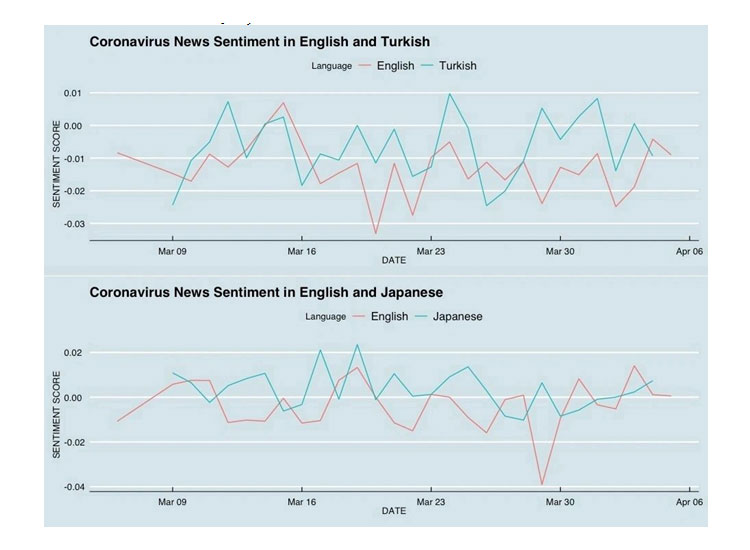Does Geography Change Interpretation and Relevance of Local News Sentiment
In our insight on April 8, 2020, we had spoken about the significance of unstructured data analysis for local news to understand the underlying sentiment. On news flow sentiment analysis, often the question is being asked: In this day and age of global interconnection, does local news matter anymore?
Anyone with experience watching news in multiple languages for the same country will confirm that it is possible that the difference actually matters. Our experience with news collection for different countries in different languages confirms this. English news and translated (from local language to English) news can be quite different.
When news flow is different, sentiment analysis will not be the same. So, there are situations when the sentiment analysis scores could be different. Let us first look at the two samples below (from the 8th April blog) on Average Coronavirus News Sentiment in English and as compared to Local Languages.
Fig.1: Average Coronavirus News Sentiment in English and Local Languages (Source: EMAlpha local news sentiment analysis)

The news in local language and English news differences from the same geography is one key aspect that gets captured by machines. However, it tells a lot about relative importance of issues how the same matter gets coverage in different countries. We have noticed important differences in how the ongoing India-China standoff on boundary disputes in Ladakh is being covered by Chinese and Indian media. In this write-up, we talk about a few things which EMAlpha machines have captured.
The first and foremost is that Indian media is promptly highlighting the ‘Chinese aggression’. Till a few weeks ago, most of the news about China in Indian media was about two things, a) How Coronavirus spread from Wuhan, b) How the manufacturing shift will take place from China and how India could be a beneficiary. Now and when it comes to China, the border dispute had completely relegated any other issue for Indian Media, both print and electronic.
This is just so different in Chinese media on major issues related with India. On India, the Chinese media is mostly covering how the Coronavirus pandemic is getting worse in the country and how the numbers are rising. The border standoff is hardly getting much coverage. Irrespective of the on-ground situation, the relative importance of the same issue is just so different for India and China. While Indian media is getting so restless about the ‘Chinese aggression’, the Chinese media has virtually ignored the conflict.
This actually reminds us of the Doklam conflict between India and China in 2017. We had done a few collaborative pieces with other another researcher from China on this issue. In this exercise, we have looked at the same Doklam issue from the perspective of India and China. It was clear even then that the kind of coverage Indian media had on this issue was so different in quantum while Chinese media was covering it much less. The other difference was in tone of expression and in general, the Indian media was much more aggressive than their Chinese counterparts.
So effectively there are two dimensions on how an issue gets coverage in news, a) the local language vs. English in same geography (for example, the English and Hindi news coverage in India or English and Mandarin news coverage in China), b) the other is how Indian news is looking at an issue and how much prominence the same issue gets in China. The news captured under both these dimensions is so different that sentiment analysis offers completely different results.
It is always true that there are three versions of each and every story whenever there is a conflict: Your version, My version and the third: an independent and objective version. Truth is subjective in these situations often. This has significance for news and sentiment analysis. The source and collection of news need to be unbiased and then the analysis has to be done objectively. This is where machines score heavily over humans.
Research Team
EM Alpha LLC
For more EMAlphainsights on Emerging Markets, please visit https://emalpha.com/insights/. To know how you can use EMAlpha’s unstructured data on Emerging Markets for better investment decisions, please send us an email at [email protected].
About EMAlpha:
EMAlpha, a data analytics and investment management firm focused on making Emerging Markets (EMs) accessible to global investors and unlocking EM investing using machines. EMAlpha’s focus is on Unstructured Data as the EMs are particularly susceptible to swings in news flow driven investor sentiment. We use thoroughly researched machine learning tools to track evolving sentiment specifically towards EMs and EMAlpha pays special attention to the timely measurement of news sentiment for investors as these markets can be finicky and sentiment can be capricious.Our team members have deep expertise in research and trading in multiple Emerging Markets and EMAlpha’s collaborative approach to combining machine learning tools with a fundamental approach help us understand these markets better.
Disclaimer:
This insight article is provided for informational purposes only. The information included in this article should not be used as the sole basis for making a decision as to whether or not to invest in any particular security. In making an investment decision, you must rely on your own examination of the securities and the terms of the offering. You should not construe the contents of these materials as legal, tax, investment or other advice, or a recommendation to purchase or sell any particular security. The information included in this article is based upon information reasonably available to EMAlpha as of the date noted herein. Furthermore, the information included in this site has been obtained from sources that EMAlpha believes to be reliable; however, these sources cannot be guaranteed as to their accuracy or completeness. Information contained in this insight article does not purport to be complete, nor does EMAlpha undertake any duty to update the information set forth herein. No representation, warranty or undertaking, express or implied, is given as to the accuracy or completeness of the information contained herein, by EMAlpha, its members, partners or employees, and no liability is accepted by such persons for the accuracy or completeness of any such information. This article contains certain “forward-looking statements,” which may be identified by the use of such words as “believe,” “expect,” “anticipate,” “should,” “planned,” “estimated,” “potential,” “outlook,” “forecast,” “plan” and other similar terms. Examples of forward-looking statements include, but are not limited to, estimates with respect to financial condition, results of operations, and success or lack of success of certain investment strategy. All are subject to various factors, including, but not limited to, general and local economic conditions, changing levels of competition within certain industries and markets, changes in interest rates, changes in legislation or regulation, and other economic, competitive, governmental, regulatory and technological factors affecting the operations of the companies identified herein, any or all of which could cause actual results to differ materially from projected results.



